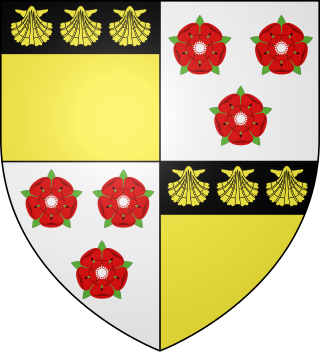Sources
- G. E. C., ed. Geoffrey F. White. The Complete Peerage. (London: St. Chaterine Press, 1953) Vol. XII, Part 1, p. 32.
William Somerville, 2nd Lord Somerville (died 20 August 1456) was a member of the Scottish Parliament in the mid-15th century. He is the first person to have clearly held the title Lord Somerville, having been created such in 1445, although other sources suggest that his father was the first Lord. [1]
William Somerville was the son of Sir Thomas Somerville and his wife Janet Stewart. William Somerville married Janet Mowat. Their eldest daughter Marie married Ralph Weir, and another daughter Janet married James Cleilland of Cleilland. A younger son, William Somerville, married Margaret Hamilton of Preston and founded the Somerville of Plane family near Stirling. William's older son and heir, John Somerville, 3rd Lord Somerville, married Helen Hepburn, daughter of Sir Adam Hepburn by Janet Borthwick, then secondly married Mariotta Baille. William died on 20 August 1456 of a surfeit of fruit. [2]
In March 1478 his widow Janet, Lady Craigmillar sued John, Lord Somerville, for goods and silverware which belonged to her by right of terce. [3]
William Sinclair (1410–1480), 1st Earl of Caithness (1455–1476), last Earl (Jarl) of Orkney, 2nd Lord Sinclair and 11th Baron of Roslin was a Norwegian and Scottish nobleman and the builder of Rosslyn Chapel, in Midlothian.
Patrick Hepburn, 1st Earl of Bothwell was Lord High Admiral of Scotland. He rose to political prominence after supporting James IV against his father, and was proxy at the King's marriage.
Sir Patrick Hepburn of Dunsyre, 1st Lord Hailes was the feudal lord of Hailes and its castle in East Lothian and a Lord of Parliament.

James Douglas, the 4th Lord of Dalkeith, was created the 1st Earl of Morton in 1458.
George Leslie, 4th Earl of Rothes was a Scottish nobleman and diplomat.
Alexander Livingston, 5th Lord Livingston of Callendar PC was the guardian of Mary, Queen of Scots, during her childhood.
Sir Alexander Home of that Ilk, 1st Lord Home was in 1448 Sheriff Deputy for Berwickshire, and was made a Lord of Parliament on 2 August 1473. He is an ancestor of the Earls of Home.
Sir Robert Lauder of Popill was a Scottish landowner and an adherent of Mary, Queen of Scots.
George Gordon, 2nd Earl of Huntly was a Scottish nobleman and Chancellor of Scotland from 1498 to 1501.

Lord Somerville is a title in the Peerage of Scotland which is subject to a number of ambiguities. The date of creation is not known with certainty but it was probably created about 1435 for Thomas Somerville, Justiciar of Scotland. The title was omitted in 1606 when an ordered list of the Scottish peerage was produced following the union of the Scottish and English crowns, and the title was not used during the 17th century. In 1723, however, the House of Lords ratified and acknowledged the title for James Somerville the 13th Lord. The consecutive numbers ascribed to the numerous Lords differ according to which authority is consulted. The list below uses the numbers favoured by Burkes Peerage.
William Hay, 17th Earl of Erroll, known as Lord Hay until 1778, was a Scottish peer.

Duncan Campbell, 1st Lord Campbell (Classical Gaelic Donnchadh mac Cailein, and also called Donnchadh na-Adh of Loch Awe,, was a Scottish nobleman and politician. He was an important figure in Scottish affairs in the first half of the 15th century and Justiciar of Argyll. He was head of the Clan Campbell for 40 years.
Janet Beaton, Lady of Branxholme and Buccleugh (1519–1569) was an aristocratic Scottish woman and a mistress of James Hepburn, Earl of Bothwell. She had a total of five husbands. One of her nieces was Mary Beaton, one of the four ladies-in-waiting of Mary, Queen of Scots, known in history as the four Marys. In her lifetime, she was accused of having been a witch. Janet was immortalised as Sir Walter Scott's Wizard Lady of Branxholm in his celebrated narrative poem "Lay of the Last Minstrel".
John Somerville, 3rd Lord Somerville was the son of William Somerville, 2nd Lord Somerville and Janet Mowat. He was a member of the Scottish Parliament. In 1449 he fought with the Scots who defeated the English at Sark. He was also present at the siege of Roxburgh in 1460 during which James II of Scotland died.

William Graham, 1st Earl of Montrose was a Scottish Lord of Parliament, who was raised to an earldom by James IV of Scotland and who died with his monarch at the Battle of Flodden.
Hugh Somerville, 5th Lord Somerville was a lord of the Parliament of Scotland. He is sometimes reckoned to be the 4th Lord Somerville. He succeeded his brother, John Somerville, 4th Lord Somerville. Hugh and John were sons of William Somerville, Master of Somerville, and Marjory Montgomerie.
Thomas Somerville, 1st Lord Somerville,, was a Lord of the Parliament of Scotland.
George Seton IV, 6th Lord Seton was a Lord of the Parliament of Scotland.
Sir Alexander Stewart of Darnley was a Scottish nobleman, and a patrilineal ancestor of James VI and I.

Admiral Kenelm Somerville, 17th Lord Somerville was a Royal Navy officer and Scottish hereditary peer. He joined the navy in 1801 and served throughout the Napoleonic Wars, fighting at the invasion of Isle de France, Battle of Tamatave, and invasion of Java. He was promoted to commander in 1811 and in 1813 took command of the troopship HMS Thames which he sailed to North America to fight in the War of 1812. Promoted to post-captain in 1814, he commanded a flotilla in the expedition that burned Washington. Somerville retired from the navy in 1846 and continued to be promoted on the retired list, becoming an admiral in 1862. He inherited the title of Lord Somerville from his brother in 1842 and died at Newbold Comyn in 1864 at the age of 76.